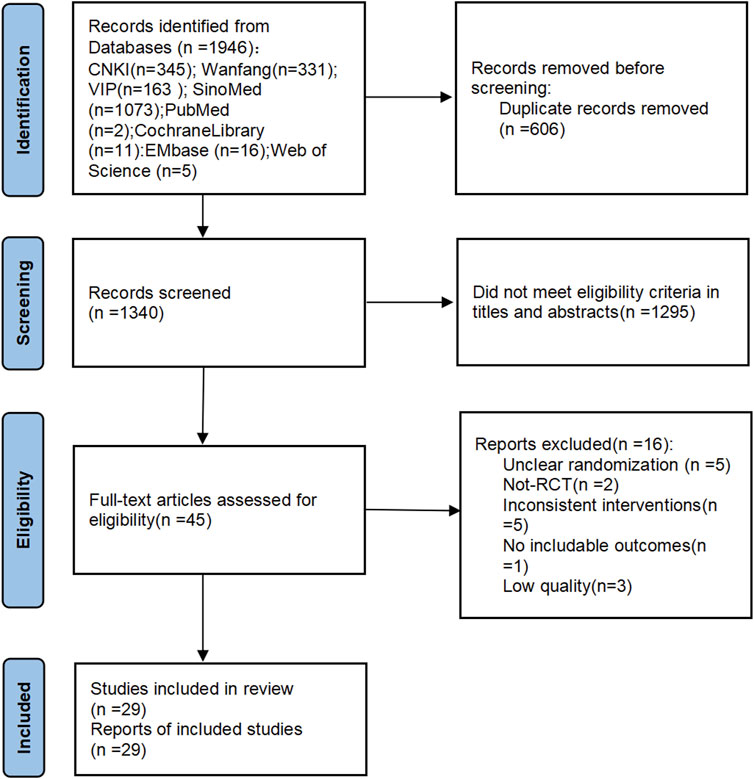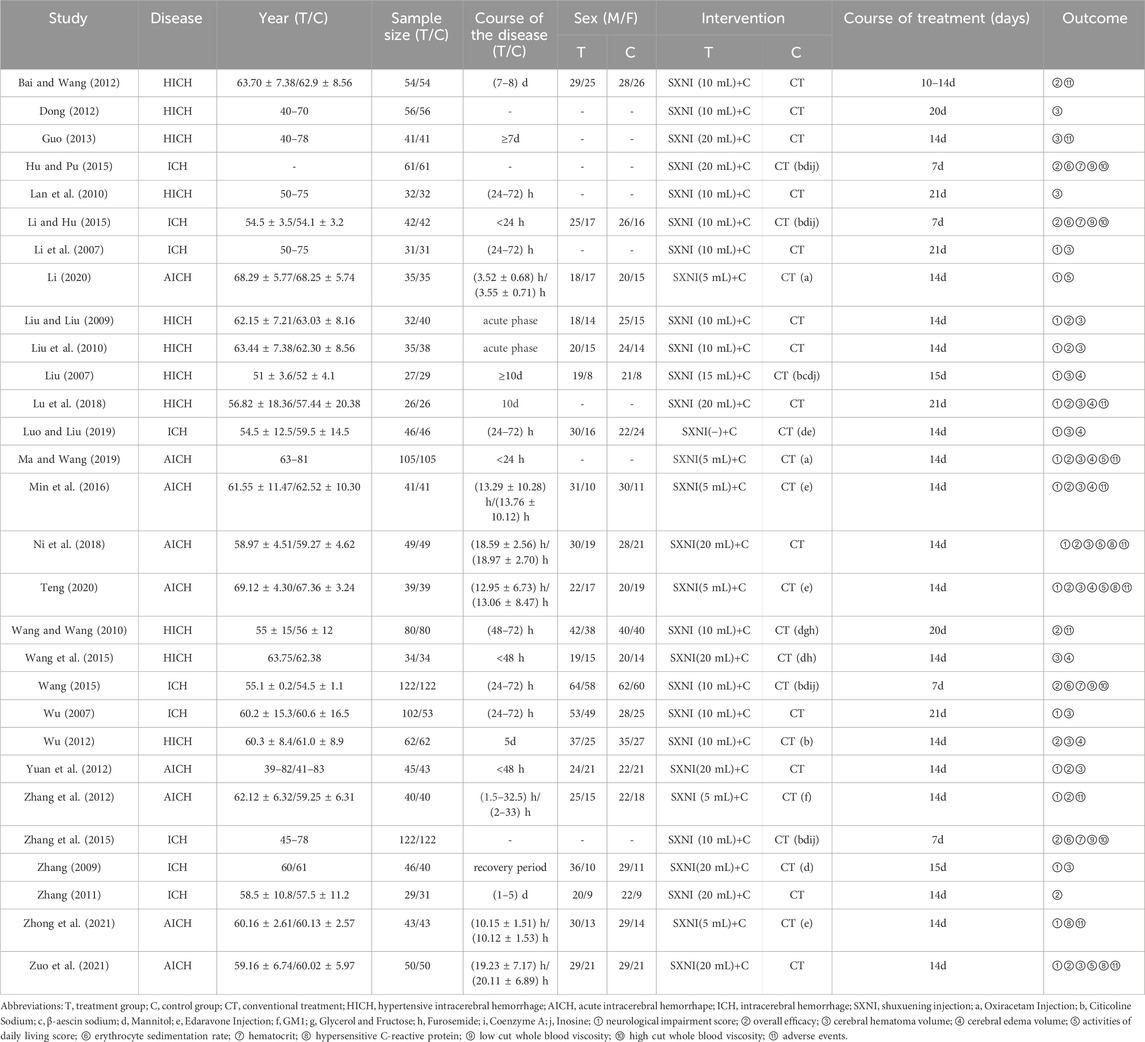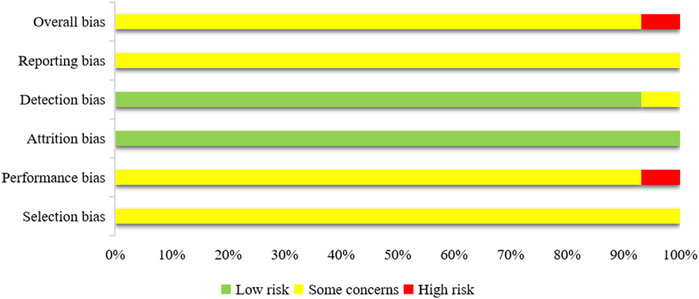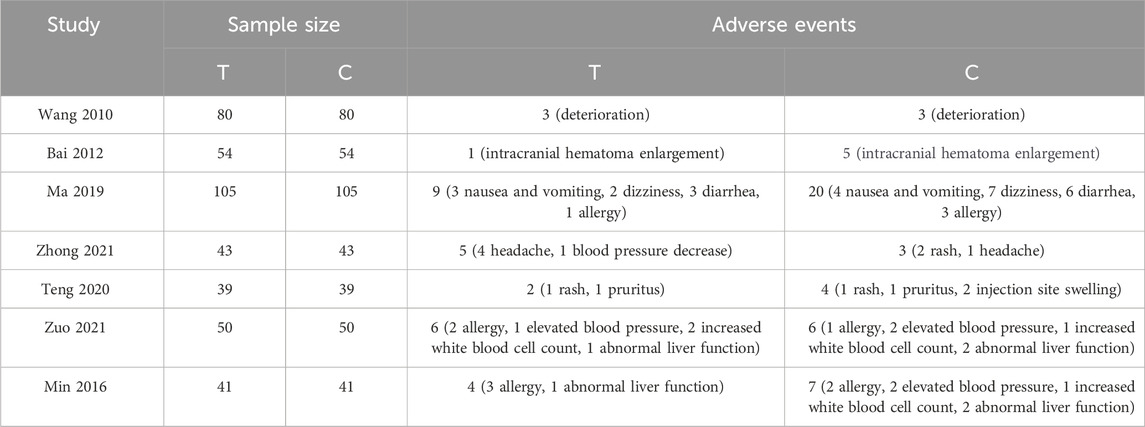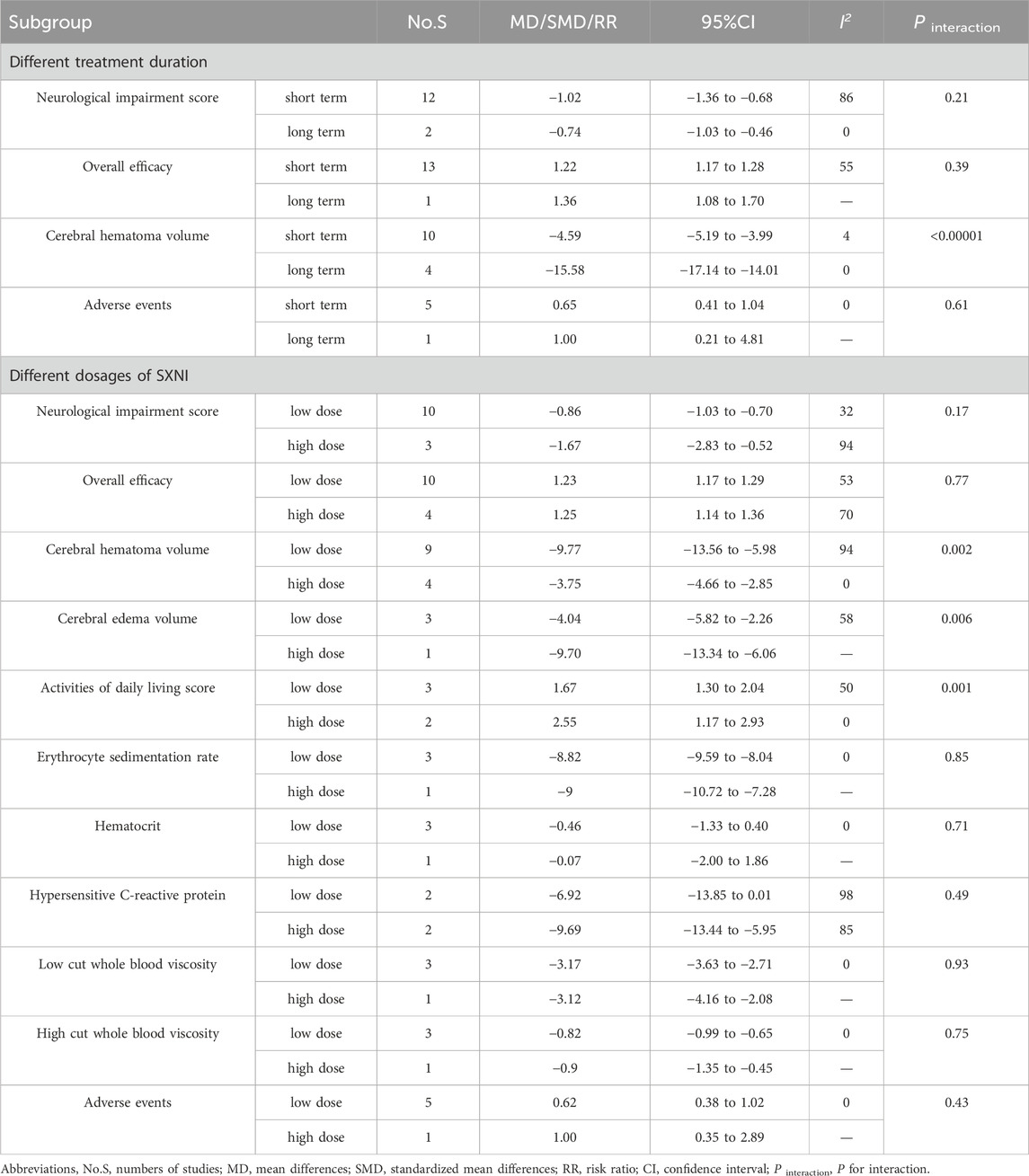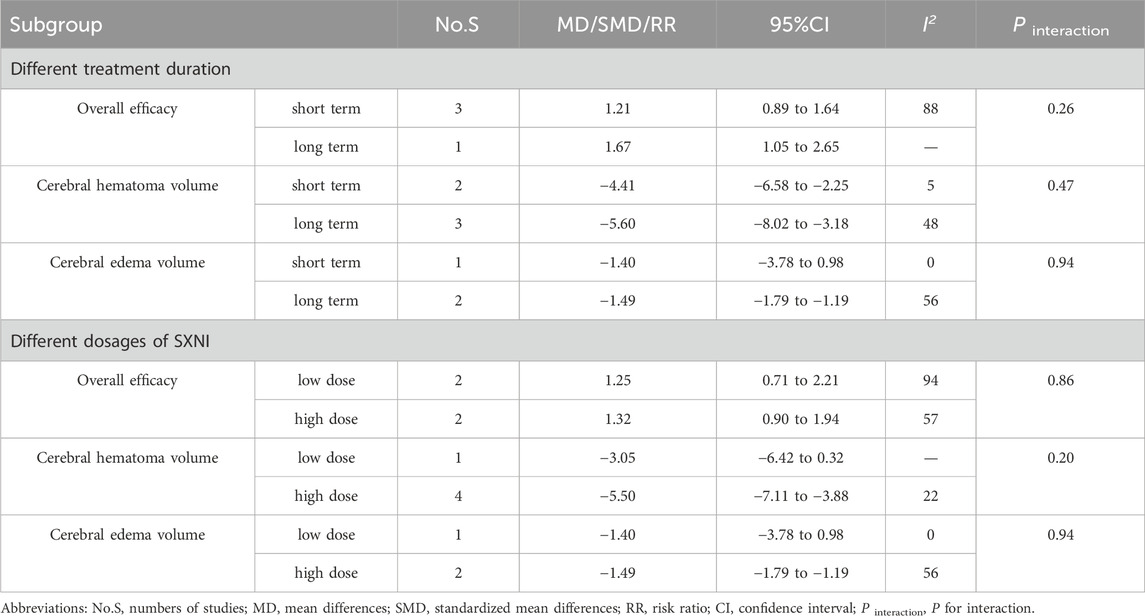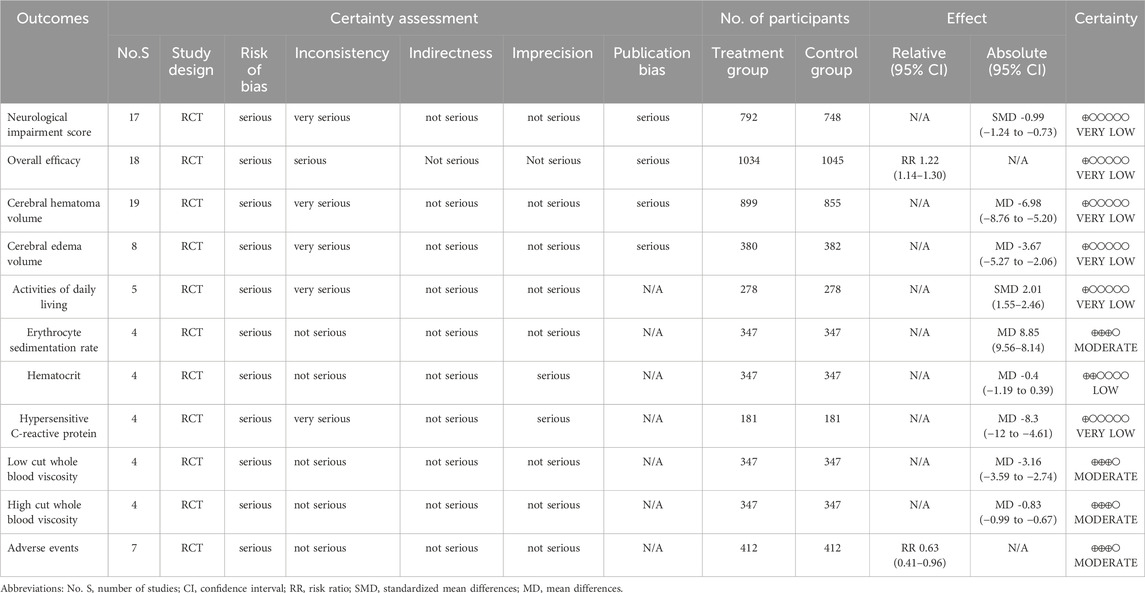- 1Evidence-Based Medicine Center, Tianjin University of Traditional Chinese Medicine, Tianjin, China
- 2First Teaching Hospital of Tianjin University of Traditional Chinese Medicine, National Clinical Research Center for Chinese Medicine Acupuncture and Moxibustion, Tianjin, China
- 3School of Chinese Materia Medica, Tianjin University of Traditional Chinese Medicine, Tianjin, China
Objective: To evaluate the efficacy and safety of Shuxuening injection (SXNI) in the treatment of patients with intracerebral hemorrhage (ICH).
Methods: This study included randomized controlled trials published before 1 June 2024 in eight databases. Patients with ICH were included, with the control group receiving conventional treatment (CT) and the treatment group receiving additional SXNI on this basis. The primary outcome was neurological impairment score. The secondary outcomes were overall efficacy, cerebral hematoma volume, cerebral edema volume, activities of daily living (ADL) score, erythrocyte sedimentation rate (ESR), hematocrit (HCT), hypersensitive C-reactive protein (hs-CRP), low cut whole blood viscosity, high cut whole blood viscosity and adverse events (AE). The methodological quality of the included studies was assessed using the revised Cochrane Risk of Bias tool (ROB 2.0). For binary variables, risk ratios (RR) were calculated, while for continuous variables, mean differences (MD) or standardized mean differences (SMD) were calculated, based on 95% confidence intervals (CI).
Results: A total of 29 trials involving 3,012 participants were included. Compared with the control group, the treatment group demonstrated better performance in reducing neurological impairment score [SMD = −0.99, 95% CI −1.24, −0.73], improving overall efficacy [RR = 1.22, 95% CI 1.14, 1.30] and ADL score [SMD = 2.01, 95%CI 1.55, 2.46], as well as decreasing the cerebral hematoma volume [MD = −6.98, 95% CI −8.76, −5.20] and cerebral edema volume [MD = −3.67, 95%CI -5.27, −2.06], with statistically significant differences observed. Meanwhile, the incidence of AE in the treatment group was lower than that in the control group, with a statistically significant difference [RR = 0.63, 95%CI 0.41, 0.96].
Conclusion: This study indicates that the combined use of SXNI and CT may be beneficial for the treatment of patients with cerebral hemorrhage compared to the use of CT alone. However, due to the moderate to very low certainty of evidence, it is advisable to conduct highquality clinical trials to validate the findings of this study.
1 Introduction
Intracerebral hemorrhage (ICH), a subtype of stroke, refers to the non-traumatic rupture of cerebral vessels, leading to the accumulation of blood within the brain parenchyma. Among the various subtypes of stroke, ischemic stroke accounts for approximately 65.3% of all recorded strokes. Following ischemic stroke, cerebral hemorrhage is the second most common subtype, with about 3.4 million cases, representing 28.8% of all stroke cases. Despite the higher incidence of ischaemic stroke, it was noteworthy that the total number of disability-adjusted life-years (DALYs) attributable to ICH surpasses that of ischaemic stroke. Specifically, ICH accounts for 79.5 million DALYs, representing 49.6% of the total DALYs assigned to stroke, which was higher than the 43.8% contributed by ischemic stroke. In terms of the incidence and fatal rates, ICH has an incidence rate of 40.8 per 100,000 people and a mortality rate of 39.1 per 100,000 people (GBD, 2021 Stroke Risk Factor Collaborators et al., 2024). The high incidence and disability rates of ICH not only significantly impair patients’ health and quality of life, but also impose a substantial economic burden on society (Qiao et al., 2012; Park et al., 2018; Xiao et al., 2019).
The causes of ICH include deep perforating vasculopathy, cerebral amyloid angiopathy, cerebral arteriovenous malformation, dural arteriovenous fistula, cerebral cavernous malformation, cerebral venous thrombosis, reversible cerebral vasoconstriction syndrome, and tumors (Bushnell et al., 2024; Hilkens et al., 2024). The pathological mechanism of ICH is due to the rupture and bleeding of small arteries caused by the mass effect of the hematoma, which subsequently leads to brain damage (Keep et al., 2012). And then, bleeding activates delayed molecular mechanisms, such as microglial activation, the influx of inflammatory cells, thrombin-induced toxicity, and iron-induced toxicity (Wilkinson et al., 2018). These processes promote the breakdown of the blood-brain barrier and contribute to the development of vasogenic and cytotoxic perihematomal edema, which may manifest from a few days to several weeks following the occurrence of ICH (Cliteur et al., 2023).
Conventional treatment methods for ICH in clinical practice include antihypertensive therapy, hemostasis therapy, anticoagulation reversal, as well as surgical intervention (Hilkens et al., 2024; Li et al., 2024). These approaches aim to reduce the risk of hematoma expansion (HE) and decrease hemorrhage-related mortality in trauma patients experiencing extracranial and ICH. However, there remains controversy regarding the therapeutic efficacy and safety of drug control over hematoma expansion, as well as the potential for secondary injuries that may arise from surgical interventions (Song et al., 2024; Zhang H. et al., 2024). Moreover, current treatment options still have some limitations in terms of neuroprotective therapy, reducing blood inflammation, and improving prognosis (Cordonnier et al., 2018; Li et al., 2024).
Shuxuening injection (SXNI) is a preparation derived from Ginkgo Biloba extract (GBE), primarily composed of total flavonol glycosides and ginkgolides. Supplementary Material S1 contains comprehensive details about SXNI. Now, GBE is widely utilized in clinical settings as an alternative or adjunctive treatment for cardiovascular and cerebrovascular diseases (Yuan et al., 2023; Liu et al., 2024b; Zhang C. et al., 2024). Clinical studies demonstrate that SXNI was effective in preserving neural function, reducing inflammation, and facilitating the absorption of hematomas (Dong, 2012; Hu and Pu, 2015; Lu et al., 2018). This may be related to Ginkgolides may reduce blood inflammation by inhibiting the toll-like receptor 4 (TLR4) and nuclear factor κB (NF-κB) pathways (Li X. et al., 2020). It also mitigated inflammatory insults through the suppression of the CD40/NF-κB pathway and played a protective role in glutamate-induced astrocytes by regulating the Wnt and Hippo pathways (Wang et al., 2021; Li et al., 2023). And flavonoids may diminish vascular inflammatory responses by decreasing the expression of vascular cell adhesion molecule 1(VCAM-1) and intercellular adhesion molecule 1(ICAM-1), as well as reducing levels of proinflammatory factors.
The efficacy and safety of SXNI in patients with ICH are issues of significant concern to clinicians and researchers. A considerable number of clinical studies on the treatment of ICH with SXNI have been published to date, but their results vary and the quality was uneven, necessitating a systematic evidence synthesis (Zhang, 2009; Wang, 2015; Ni et al., 2018; Ma and Wang, 2019). This study utilizes the systematic review/Meta-analysis approach to assess the randomized controlled trials on SXNI for the treatment of ICH, with the aim of clarifying its efficacy and safety, and to offer guidance for clinical application.
2 Methods
2.1 Study registration and reporting guideline
The protocol for this study was registered in the International Prospective Register of Systematic Reviews (ID:CRD42024603769). This study followed the reporting guideline of the Preferred Reporting Items for Systematic Reviews and Meta-Analyses 2020 (PRISMA 2020) (Page et al., 2021).
2.2 Ethical statement
As this is a literature review, there is no need for ethical approval.
2.3 Search strategy
The two researchers independently searched four Chinese databases (CNKI, Wanfang, VIP, and SinoMed) and four English databases (PubMed, Cochrane Library, Embase, and Web of Science). The search time range was from the establishment of the database to 1 June 2024. Using a combination of subject terms and free-text terms for searching. The search query in PubMed is shown below, and the search queries for other databases can be found in Supplementary Material S2.
#1 “Cerebral Hemorrhage” [Mesh] OR “Hemorrhage, Cerebrum [Title/Abstract]” OR “Cerebrum Hemorrhage [Title/Abstract]” OR “Cerebrum Hemorrhages [Title/Abstract]” OR “Hemorrhages, Cerebrum [Title/Abstract]” OR “Cerebral Parenchymal Hemorrhage [Title/Abstract]” OR “Cerebral Parenchymal Hemorrhages [Title/Abstract]” OR “Hemorrhage, Cerebral Parenchymal [Title/Abstract]” OR “Hemorrhages, Cerebral Parenchymal [Title/Abstract]” OR “Parenchymal Hemorrhage, Cerebral [Title/Abstract]” OR “Parenchymal Hemorrhages, Cerebral [Title/Abstract]” OR “Intracerebral Hemorrhage [Title/Abstract]” OR “Hemorrhage, Intracerebral [Title/Abstract]” OR “Hemorrhages, Intracerebral [Title/Abstract]” OR “Intracerebral Hemorrhages [Title/Abstract]” OR “Hemorrhage, Cerebral [Title/Abstract]” OR “Cerebral Hemorrhages [Title/Abstract]” OR “Hemorrhages, Cerebral [Title/Abstract]” OR “Brain Hemorrhage, Cerebral [Title/Abstract]” OR “Brain Hemorrhages, Cerebral [Title/Abstract]” OR “Cerebral Brain Hemorrhage [Title/Abstract]” OR “Cerebral Brain Hemorrhage Cerebral Brain Hemorrhages [Title/Abstract]” OR “Hemorrhage, Cerebral Brain [Title/Abstract]” OR “Hemorrhages, Cerebral Brain [Title/Abstract].”
#2 “ginkgo biloba” [MeSH Terms] OR “Ginkgo” [Title/Abstract] OR “Ginkgo biloba” [Title/Abstract] OR “Yinxing” [Title/Abstract] OR “Yinxingye” [Title/Abstract] OR “Shuxuening” [Title/Abstract] OR “Ginaton” [Title/Abstract].
#3 Clinical Trial [Publication Type] OR randomized controlled study [Title/Abstract] OR randomized controlled trial [Title/Abstract] OR randomized study [Title/Abstract] OR randomized trial [Title/Abstract] OR randomized placebo-controlled study [Title/Abstract] OR randomized placebo-controlled trial [Title/Abstract] OR randomized placebo controlled [Title/Abstract] OR randomized placebo-controlled [Title/Abstract] OR randomized double-blind [Title/Abstract] OR randomized double blin [Title/Abstract].
#4 #1 AND #2 AND #3.
2.4 Eligibility criteria
2.4.1 Inclusion criteria
1) Type of studies: All randomized controlled trials (RCTs) in both Chinese and English were included.
2) Participants: This study included participants who met the diagnostic criteria for ICH outlined in the Guidelines for the Diagnosis and Treatment of Cerebral Hemorrhage in China (2019) and Stroke (Chinese Society of Neurology and Chinese Stroke Society, 2019; Hilkens et al., 2024). The specific diagnostic criteria can be found in Supplementary Material S3. There were no restrictions on age, gender, race, or cause of disease.
3) Interventions and comparison: The control group received conventional treatment (including dehydrating agents, neurotrophic agents, cerebral cell activators, and symptomatic supportive therapies, such as mannitol, coenzyme A, inosine, etc.). The treatment group was treated with SXNI on the basis of conventional treatment.
4) Outcomes: The primary outcome was the neurological impairment score measured using standardized tools, including National Institute of Health Stroke Scale (NIHSS), European Stroke Scale (ESS), and China Stroke Scale (CSS). The secondary outcomes were overall efficacy, cerebral hematoma volume, cerebral edema volume, activities of daily living (ADL) score, erythrocyte sedimentation rate (ESR), hematocrit (HCT), hypersensitive C-reactive protein (hs-CRP), low cut whole blood viscosity, high cut whole blood viscosity and adverse events (AE). The specific criteria of the overall efficacy can be found in Supplementary Material S4. The outcomes included in the studies should at least encompass one of the primary or secondary outcomes.
2.4.2 Exclusion criteria
1) The data were incomplete or incorrect. 2) Participants with other major diseases or those who had undergone surgical treatment were excluded from the study. 3) Studies involving other traditional Chinese medicine interventions or inconsistent conventional treatments were excluded.
2.5 Literature screening and data extraction
Two reviewers independently conducted literature screening and data extraction and cross-checked in strict accordance with the eligibility criteria. If there was any disagreement, the third reviewer would discuss and solve the problem. The retrieved literature was imported into NoteExpress to exclude duplicate studies, then screening the titles and abstracts of the studies, and the full text was further screened. Data extraction was performed on the final included literature, including disease name, year, sample size, course of the disease, sex, intervention, course of treatment, outcome, and adverse events. Data extraction were independently completed and verified by two researchers, and disagreements were resolved through discussion or with the assistance of a third researcher.
2.6 Quality assessment
The methodological quality of the included studies was assessed using the revised Cochrane Risk of Bias tool (ROB 2.0), including five areas: 1) randomization process (selection bias); 2) deviations from the intended interventions (performance bias); 3) missing outcome data (attrition bias); 4) measurement of the outcome (detection bias); 5) selection of the reported outcome (reporting bias) (Liu et al., 2021). The judgments for these domains were rated as three levels: low risk, some concerns and high risk. Finally, the overall bias was determined by summarizing the risk of bias across each domain. Risk of bias assessment were independently completed and verified by two researchers, and disagreements were resolved through discussion or with the assistance of a third researcher.
2.7 Statistical analysis
Statistical analysis was performed using Review Manager 5.3 and Stata 15.0. The dichotomous variables were expressed as risk ratios (RR), and the continuous variables were expressed as SMD or mean differences (MD) according to whether the measurement methods was different. The results were expressed as effect size with a 95% confidence interval (CI). Heterogeneity among studies was determined using the Chi2 test and reported as I2. When I2 was less than or equal to 50%, it was considered that the heterogeneity was low, and a fixed-effects model was used for pooling the results. Conversely, when I2 was greater than 50%, it was deemed that there was high heterogeneity, subgroup analysis and sensitivity analysis were used to identify the sources of heterogeneity. If the sources of heterogeneity could not be pinpointed, a random-effects model was employed for the meta-analysis. The efficacy and safety of interventional therapy might vary significantly depending on the timing of treatment initiation in patients with ICH, and 72 h represents a critical therapeutic time point (Zhou et al., 2012; Chinese Society of Neurology and Chinese Stroke Society, 2019; Li et al., 2024). Therefore, based on the disease course, patients were divided into two subgroups: the disease course ≥72 h group and the disease course <72 h group. Additionally, subgroup analyses would also be conducted based on differences in treatment duration and SXNI dosage across the groups. Funnel plots were used to assess the publication bias.
2.8 Evidence certainty assessment
The certainty of evidence was assessed using the GRADE methodology, which categorizes it as high, moderate, low, or very low (Guyatt et al., 2008). Two reviewers independently evaluated the certainty of evidence for each outcome, with a third reviewer consulted to resolve any discrepancies. Detailed guidelines for assessing the certainty of evidence can be found in Supplementary Material S5.
3 Results
3.1 Literature search and screening
Through database searches, a total of 1,946 studies were retrieved. Among them, 606 duplicate studies were excluded, and 1,340 studies were excluded because their titles and abstracts did not meet the eligibility criteria. The remaining 45 studies underwent full-text assessment. After full-text assessment, 16 studies were excluded due to the following reasons: 1) Unclear randomization (n = 5); 2) Not-RCT (n = 2); 3) Inconsistent interventions (n = 5); 4) No includable outcomes (n = 1); 5) The quality of the literature is extremely low (n = 3). Finally, 29 studies were included (Li et al., 2007; Liu, 2007; Wu, 2007; 2012; Liu and Liu, 2009; Zhang, 2009; 2011; Lan et al., 2010; Liu et al., 2010; Wang and Wang, 2010; Bai and Wang, 2012; Dong, 2012; Yuan et al., 2012; Zhang et al., 2012; 2015; Guo, 2013; Hu and Pu, 2015; Li and Hu, 2015; Wang, 2015; Wang et al., 2015; Min et al., 2016; Lu et al., 2018; Ni et al., 2018; Luo and Liu, 2019; Ma and Wang, 2019; Li, 2020; Teng, 2020; Zhong et al., 2021; Zuo et al., 2021) (Figure 1).
3.2 Characteristics of included studies
The total sample size of the 29 included studies was 3,012 participants, with 1,527 in the treatment group and 1,485 in the control group. These studies were published between 2007 and 2021, all in Chinese. These studies compared the efficacy and safety of SXNI combined with CT versus CT alone. The medications used in CT included oxiracetam injection, citicoline sodium, mannitol, edaravone injection, GM1, glycerol and fructose, furosemide, coenzyme A, inosine, β-aescin sodium. The average age of the patients ranged from 51.00 to 69.12, and the course of treatment ranged from 1 to 3 weeks. In the majority of the trials, males outnumbered females. No significant disparities were observed in the baseline characteristics across all the studies. The specific characteristics are shown in Table 1.
3.3 Risk of bias assessment
The 29 studies were assessed based on the five domains of ROB 2.0. In terms of the randomization process, 29 studies reported that the order of allocation was randomized, baseline balanced between groups, and were rated as some concern. Regarding deviations from intended interventions, the outcomes of 27 studies were not easily affected by the research environment and were rated as some concerns; 2 studies (Wang and Wang, 2010; Zhang et al., 2012) had outcomes that were more susceptible to bias due to environmental influences, which were rated as high risk. In terms of missing outcome data, none of the 29 studies reported any dropout cases, and all outcome data were complete, which was rated as low risk. For outcome measurement, although 27 studies did not describe blinding of assessors, their outcomes were not easily influenced by measurement, which was rated as low risk; 2 studies (Wang and Wang, 2010; Zhang et al., 2012) had outcomes that might be somewhat influenced by measurement, which was rated as some concerns. In terms of selective reporting of results, although none of the 29 studies had a predetermined plan, none of them reported selectively, which was rated as some concerns. Among the overall risk of bias, 27 studies were rated as some concerns, and 2 studies (Wang and Wang, 2010; Zhang et al., 2012) were rated as high risk. The results of the bias risk assessment for the included studies are shown in Figure 2.
3.4 Primary outcome
3.4.1 Neurological impairment score
Seventeen studies including 1,540 patients reported the change in neurological impairment score, with high heterogeneity among the studies (I2 = 81%) (Li et al., 2007; Liu, 2007; Wu, 2007; Liu and Liu, 2009; Zhang, 2009; Liu et al., 2010; Yuan et al., 2012; Zhang et al., 2012; Min et al., 2016; Lu et al., 2018; Ni et al., 2018; Luo and Liu, 2019; Ma and Wang, 2019; Li, 2020; Teng, 2020; Zhong et al., 2021; Zuo et al., 2021) (Figure 3). The results of the sensitivity analysis indicated that excluding any single study did not reduce the significant heterogeneity of the pooled results. Therefore, a random-effects model was used to pool the results. Subgroup analysis was conducted based on the course of disease (≤72 h or >72 h). In the ≤72 h subgroup (14 RCTs including 1,346 participants), SXNI combined with CT was more effective than CT alone in reducing neurological impairment score [SMD = −0.98, 95%CI (−1.27, −0.69), p < 0.00001]. In the >72 h subgroup (3 RCTs including 194 participants), SXNI combined with CT was more effective than CT alone in reducing neurological impairment score [SMD = −1.02, 95%CI (−1.46, −0.58), p = 0.12]. No statistically significant difference was observed between the two subgroups (p = 0.89).
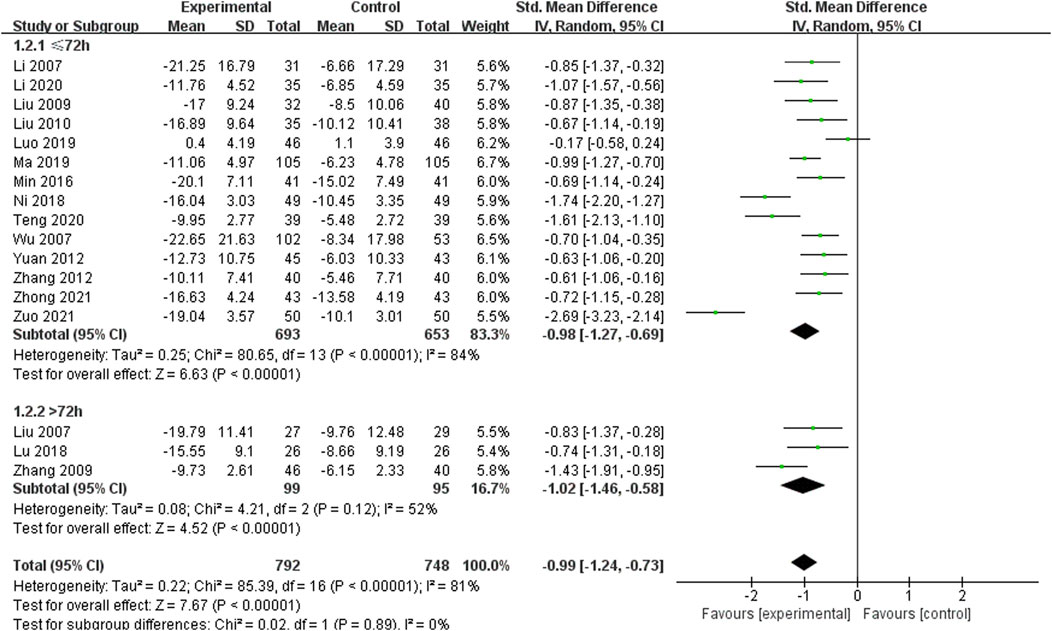
Figure 3. Meta-analysis results of the effect of Shuxuening injection combined with conventional treatment vs conventional treatment on neurological impairment score.
3.5 Secondary outcomes
3.5.1 Overall efficacy
A total of 18 studies including 2,079 patients reported overall efficacy, with high heterogeneity among the studies (I2 = 68%) (Liu and Liu, 2009; Liu et al., 2010; Wang and Wang, 2010; Zhang, 2011; Bai and Wang, 2012; Wu, 2012; Yuan et al., 2012; Zhang et al., 2012; 2015; Hu and Pu, 2015; Li and Hu, 2015; Wang, 2015; Min et al., 2016; Lu et al., 2018; Ni et al., 2018; Ma and Wang, 2019; Teng, 2020; Zuo et al., 2021) (Figure 4). The results of the sensitivity analysis indicated that excluding any single study did not reduce the significant heterogeneity of the pooled results. Therefore, a random-effects model was used to pool the results. Subgroup analysis was conducted based on the course of the disease (≤72 h or >72 h). In the ≤72 h subgroup (14 RCTs including 1,735 participants), SXNI combined with CT was more effective than CT alone in improving overall efficacy [RR = 1.21, 95% CI (1.14, 1.29), p = 0.007]. In the >72 h subgroup (4 RCTs including 344 participants), there was no difference in overall efficacy between the SXNI combined with CT and CT alone [RR = 1.28, 95% CI (0.94, 1.76), p < 0.0001]. No statistically significant difference was observed between the two subgroups (p = 0.73).
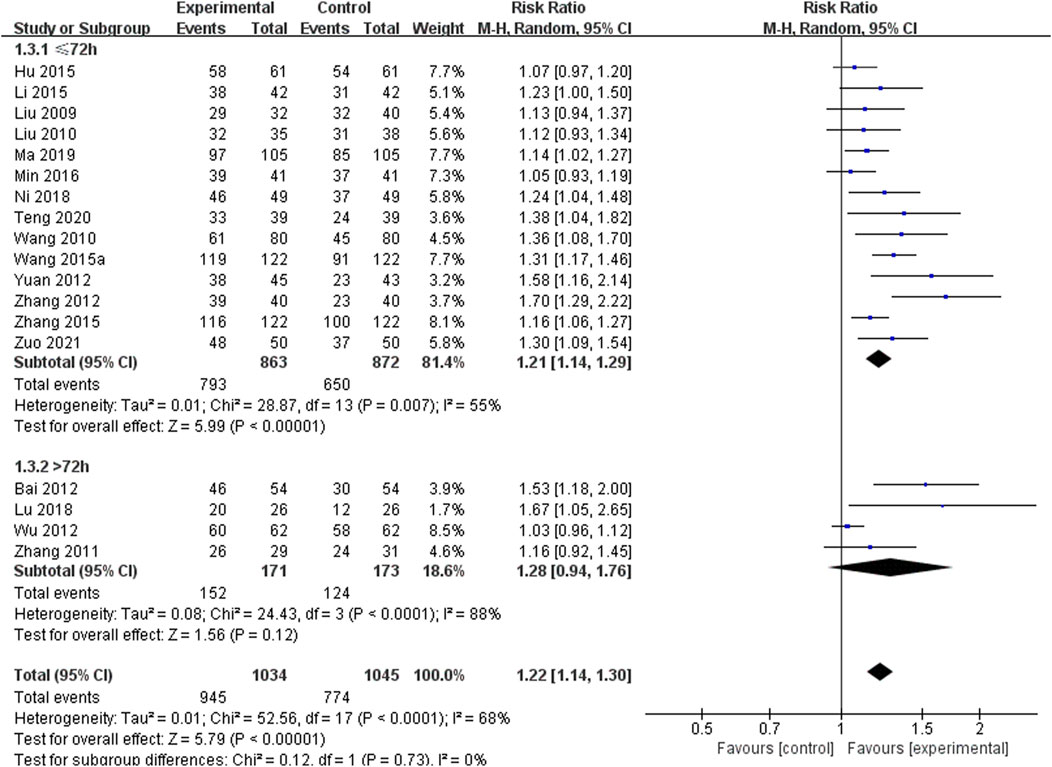
Figure 4. Meta-analysis results of the effect of Shuxuening injection combined with conventional treatment vs. conventional treatment on overall efficacy.
3.5.2 Cerebral hematoma volume
A total of 19 studies including 1,754 patients reported the cerebral hematoma volume, with high heterogeneity among the studies (I2 = 90%) (Li et al., 2007; Liu, 2007; Wu, 2007; 2012; Liu and Liu, 2009; Zhang, 2009; Lan et al., 2010; Liu et al., 2010; Dong, 2012; Yuan et al., 2012; Guo, 2013; Wang et al., 2015; Min et al., 2016; Lu et al., 2018; Ni et al., 2018; Luo and Liu, 2019; Ma and Wang, 2019; Teng, 2020; Zuo et al., 2021) (Figure 5). The results of the sensitivity analysis indicated that excluding any single study did not reduce the significant heterogeneity of the pooled results. Therefore, a random-effects model was used to pool the results. Subgroup analysis was conducted based on the course of disease (≤72 h or >72 h). In the ≤72 h subgroup (14 RCTs including 1,354 participants), SXNI combined with CT was more effective than CT alone in reducing the cerebral hematoma volume [MD = −7.65, 95% CI (−9.94, −5.36), p < 0.00001]. In the >72 h subgroup (5 RCTs including 400 participants), SXNI combined with CT was more effective than CT alone in reducing the cerebral hematoma volume [MD = −5.10, 95% CI (−6.65, −3.54), p = 0.23]. No statistically significant difference was observed between the two subgroups (p = 0.07).
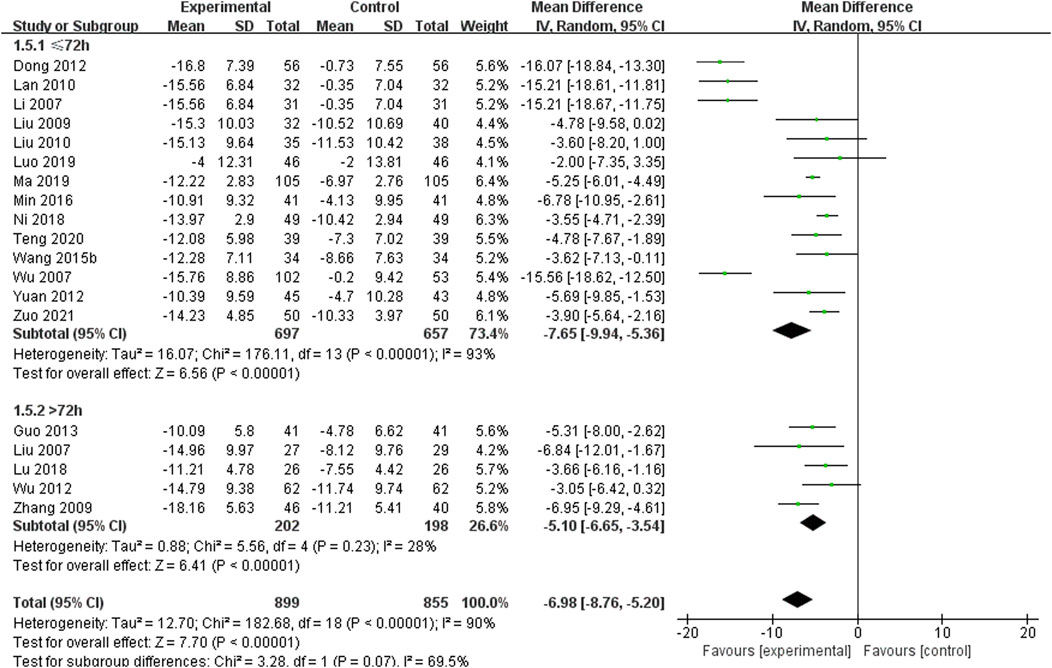
Figure 5. Meta-analysis results of the effect of Shuxuening injection combined with conventional treatment vs conventional treatment on cerebral hematoma volume.
3.5.3 Cerebral edema volume
A total of 8 studies including 762 patients reported the cerebral edema volume, with high heterogeneity among the studies (I2 = 87%) (Liu, 2007; Wu, 2012; Wang et al., 2015; Min et al., 2016; Lu et al., 2018; Luo and Liu, 2019; Ma and Wang, 2019; Teng, 2020) (Figure 6). The results of the sensitivity analysis indicated that excluding any single study did not reduce the significant heterogeneity of the pooled results. Therefore, a random-effects model was used to pool the results. Subgroup analysis was conducted based on the course of disease (≤72 h or >72 h). In the >72 h subgroup (5 RCTs including 530 participants), SXNI combined with CT was more effective than CT alone in reducing the cerebral edema volume [MD = −4.59, 95% CI (−6.64, −2.53), p = 0.002]. In the >72 h subgroup (3 RCTs including 232 participants), SXNI combined with CT was more effective than CT alone in reducing the cerebral edema volume [MD = −1.57, 95% CI (−2.41, −0.72), p = 0.32]. The comparison between subgroups showed significantly better efficacy in the <72 h subgroup than in the >72 h subgroup (p = 0.008).

Figure 6. Meta-analysis results of the effect of Shuxuening injection combined with conventional treatment vs conventional treatment on cerebral edema volume.
3.5.4 Activities of daily living score
Five studies including 556 patients reported the ADL score for patients with disease course ≤72h, showing high heterogeneity among the studies (I2 = 78%) (Ni et al., 2018; Ma and Wang, 2019; Li, 2020; Teng, 2020; Zuo et al., 2021) (Figure 7). The results of the sensitivity analysis indicated that excluding any single study did not reduce the significant heterogeneity of the pooled results. Therefore, a random-effects model was used to pool the results. The results showed that the difference between the two groups was statistically significant [SMD = 2.01, 95%CI (1.55, 2.46), p = 0.001]. It may be concluded that SXNI combined with CT has a better effect on improving the ADL score than CT alone.

Figure 7. Meta-analysis results of the effect of Shuxuening injection combined with conventional treatment vs conventional treatment on Activities of daily living score.
3.5.5 Erythrocyte sedimentation rate
Four studies including 694 patients reported the ESR for patients with disease course ≤72 h (Hu and Pu, 2015; Li and Hu, 2015; Wang, 2015; Zhang et al., 2015) (Figure 8). Due to low heterogeneity between studies (I2 = 0%), a fixed-effects model was used for analysis. The results showed the difference between the two groups was statistically significant [MD = −8.85, 95%CI (−9.56, −8.14), p = 0.91]. The ESR of SXNI combined with CT was lower than that of CT alone.

Figure 8. Meta-analysis results of the effect of Shuxuening injection combined with conventional treatment vs conventional treatment on erythrocyte sedimentation rate.
3.5.6 Hematocrit
Four studies including 694 patients reported the HCT for patients with disease course ≤72 h (Hu and Pu, 2015; Li and Hu, 2015; Wang, 2015; Zhang et al., 2015) (Figure 9). Due to low heterogeneity between studies (I2 = 0%), a fixed-effects model was used for analysis. The results showed that there was no difference in HCT between the SXNI combined with CT and CT alone [MD = −0.40, 95% CI (−1.19, 0.39), p = 0.88].

Figure 9. Meta-analysis results of the effect of Shuxuening injection combined with conventional treatment vs conventional treatment on hematocrit.
3.5.7 Hypersensitive C-reactive protein
Four studies including 362 patients reported the hs-CRP for patients with disease course ≤72h, showing high heterogeneity among the studies (I2 = 95%) (Ni et al., 2018; Teng, 2020; Zhong et al., 2021; Zuo et al., 2021) (Figure 10). The results of the sensitivity analysis indicated that excluding any single study did not reduce the significant heterogeneity of the pooled results. Therefore, a random-effects model was used to pool the results. The results showed that the difference between the two groups was statistically significant [MD = −8.30, 95%CI (−12.00, −4.61), p < 0.00001]. It may be concluded that SXNI combined with CT has a better effect on reducing the hs-CRP than CT alone.

Figure 10. Meta-analysis results of the effect of Shuxuening injection combined with conventional treatment vs conventional treatment on hypersensitive C-reactive protein.
3.5.8 Low cut whole blood viscosity
Four studies including 694 patients reported the low cut whole blood viscosity for patients with disease course ≤72 h (Hu and Pu, 2015; Li and Hu, 2015; Wang, 2015; Zhang et al., 2015) (Figure 11). Due to low heterogeneity between studies (I2 = 0%), a fixed-effects model was used for analysis. The results showed the difference between the two groups was statistically significant [MD = −3.16, 95%CI (−3.59, −2.74), p = 0.91]. The low cut whole blood viscosity of SXNI combined with CT was lower than that of CT alone.

Figure 11. Meta-analysis results of the effect of Shuxuening injection combined with conventional treatment vs conventional treatment on low cut whole blood viscosity.
3.5.9 High cut whole blood viscosity
Four studies including 694 patients reported the high cut whole blood viscosity for patients with disease course ≤72 h (Hu and Pu, 2015; Li and Hu, 2015; Wang, 2015; Zhang et al., 2015) (Figure 12). Low heterogeneity was observed among these studies (I2 = 0%). Accordingly, the fixed effect model was used for analysis. The results showed the difference between the two groups was statistically significant [MD = −0.83, 95% CI (−0.99, −0.67), p = 0.95], it combined use of SXNI and CT demonstrated a greater efficacy in reducing high cut whole blood viscosity compared to the use of CT alone.

Figure 12. Meta-analysis results of the effect of Shuxuening injection combined with conventional treatment vs conventional treatment on high cut whole blood viscosity.
3.5.10 Adverse events
A total of 11 studies including 1,136 patients reported data on specific AE (Wang and Wang, 2010; Bai and Wang, 2012; Zhang et al., 2012; Guo, 2013; Min et al., 2016; Lu et al., 2018; Ni et al., 2018; Ma and Wang, 2019; Teng, 2020; Zhong et al., 2021; Zuo et al., 2021). Of which four studies clearly stated that no AE occurred in either group (Zhang et al., 2012; Guo, 2013; Lu et al., 2018; Ni et al., 2018) (Table 2). Meta-analysis was performed for the other 7 studies (Wang and Wang, 2010; Bai and Wang, 2012; Min et al., 2016; Ma and Wang, 2019; Teng, 2020; Zhong et al., 2021; Zuo et al., 2021) (Figure 13). Due to low heterogeneity between studies (I2 = 0%), a fixed-effects model was used for analysis. In the >72 h subgroup (6 RCTs including 716 participants), there was no difference in AE between the SXNI combined with CT and CT alone [RR = 0.67, 95% CI (0.43, 1.05), p = 0.58]. In the >72 h subgroup (1 RCTs including 108 participants), there was no difference in AE between the SXNI combined with CT and CT alone [RR = 0.20, 95% CI (0.02, 1.66), p = 0.14]. In the overall result (7 RCTs including 824 participants), the meta-analysis showed that the incidence of adverse events in the SXNI combined with CT was lower than CT alone [RR = 0.63, 95% CI (0.41, 0.96), p = 0.03]. No statistically significant difference was observed between the two subgroup (p = 0.27).
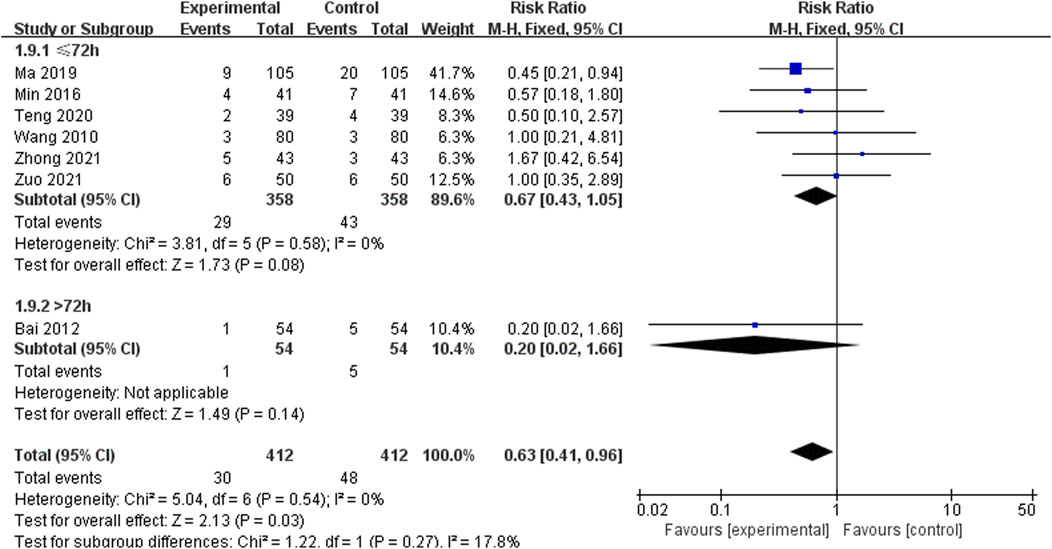
Figure 13. Meta-analysis results of the effect of Shuxuening injection combined with conventional treatment vs conventional treatment on adverse events.
3.6 Sensitivity analyses
By successively excluding literature, the combined results did not change significantly, indicating good stability of the outcomes. However, it was not possible to reduce the heterogeneity of the combined results by excluding literature. The graph of sensitivity analysis may be found in Supplementary Material S6.
3.7 Subgroup analyses
Subgroup analysis was conducted based on different SXNI doses and durations of treatment. The low-dose subgroup was defined as those who received 10 mL or less of SXNI, while the high-dose subgroup received more than 10 mL. For the duration of treatment, the short-term treatment subgroup was defined as those treated for 14 days or less, and the long-term treatment subgroup was defined as those treated for more than 14 days. The results of each subgroup analysis were consistent with the overall results (Tables 3, 4). For patients with disease course ≤72h, the long-term treatment group was superior to the short-term treatment group in alleviating cerebral hematoma volume (p interaction < 0.00001). In terms of reducing the cerebral hematoma volume, the low-dose subgroup outperformed the high-dose subgroup (p interaction = 0.002). In terms of reducing cerebral edema volume, the high-dose subgroup was superior to the low-dose subgroup (p interaction = 0.006). In improving ADL scores, the high-dose subgroup was superior to the low-dose subgroup (p interaction = 0.001).
3.8 Publication bias
Funnel plots were used to assess publication bias for the four outcomes: neurological impairment score, cerebral hematoma volume, overall efficacy and cerebral edema volume. The funnel plots of neurological deficit score (Figure 14A), cerebral hematoma volume (Figure 14B), overall efficacy (Figure 14C) and cerebral edema volume (Figure 14D) showed obvious asymmetry, suggesting that there may be publication bias in the included studies.
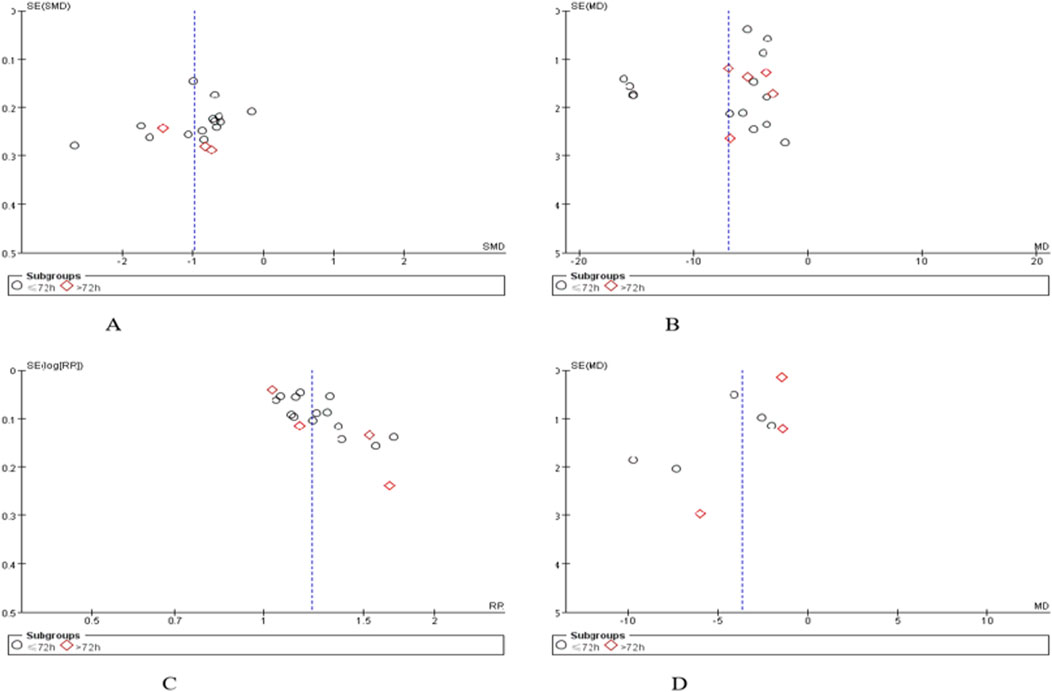
Figure 14. Publication bias assessed by funnel plots. (A) neurological impairment score, (B) cerebral hematoma volume, (C) overall efficacy, (D) cerebral edema volume.
3.9 Certainty of evidence
Table 5 shows the assessment of the certainty of evidence. According to the results, the evidence for ESR, low cut whole blood viscosity, high cut whole blood viscosity, AE were considered to moderate certainty; HCT was considered to low certainty; neurological impairment score, overall efficacy, cerebral hematoma volume, cerebral edema volume, ADL score, and hs-CRP were considered as very low certainty.
4 Discussion
4.1 Interpretation of the results
4.1.1 Efficacy
The results showed that for patients with ICH, compared to using CT alone, the combination of SXNI and CT may reduce the neurologic impairment scores and improve the ADL scores. In imaging aspects, it may decrease the cerebral hematoma and cerebral edema volume, alleviating brain tissue damage. In laboratory tests, it may lower ESR, hs-CRP, low cut whole blood viscosity and high cut whole blood viscosity, thereby improving patients’ hemorheological status. Therefore, these findings indicate that the combination of SXNI and CT for ICH may bring more clinical benefits to patients in terms of reducing brain injury and neurological impairment, and improving the ability to perform activities of daily living.
4.1.2 Safety
The meta-analysis results of adverse events showed that there was no statistically significant difference between the SXNI combined with CT and CT alone, for patients with disease course ≤72 h or >72 h. However, the overall results indicated of adverse events in the SXNI combined with CT was lower than CT alone. Considering the paucity of studies reporting adverse events, which represented a mere fraction of the total included studies, the following conclusion was advanced with circumspection: Adding SXNI to conventional treatment may not increase the occurrence of additional safety events. And it could be further inferred that, in the treatment of patients with ICH, SXNI may demonstrates satisfactory safety.
4.1.3 Subgroup analyses
According to the results of subgroup analysis, it was suggested that extending the duration of SXNI use in treating patients with disease course ≤72 h may not benefit the patients. It was noteworthy that extending the duration of SXNI use in treating patients might benefit patients in terms of reducing the cerebral hematomas volume. It was speculated that the patients’ self-healing abilities may have played a role in this effect. Increasing the dosage of SXNI may not appear to benefit patients in terms of neurological impairment score, overall efficacy, cerebral hematoma volume, ESR, HCT, low-cut whole blood viscosity, high-cut whole blood viscosity, and AE. But it may alleviate brain edema and improve prognostic outcomes. For patients with disease course >72 h of ICH, neither extending the treatment duration nor increasing the dosage of SXNI may provide benefits.
4.2 Heterogeneity
Among the 10 outcomes included, some exhibited high heterogeneity. To address this, subgroup analyses were conducted on all outcomes based on treatment duration and the dosage of SXNI administered. And sensitivity analysis was also performed by sequentially excluding individual studies. Through sequential exclusion of individual studies, the meta-analysis results did not show significant alterations. Therefore, the sources of high heterogeneity in outcomes such as neurological impairment score, overall efficacy, cerebral edema volume, and hs-CRP remain unclear. It is speculated that the sources of heterogeneity may stem from factors such as the severity of intracerebral hemorrhage or patients’ comorbid conditions. This speculation requires further verification.
4.3 Risk of bias
Due to methodological deficiencies in the included studies, there are some biases. Since none of the included studies reported allocation concealment, the risk of randomization process was judged as ‘some concerns’. Furthermore, selective reporting of results was rated as some concerns because none of the included studies reported trial registration. Overall, 93.1% of the studies were classified as some concerns regarding bias, with 6.9% classified as high risk. The assessment of publication bias indicated that four outcome measures may be subject to publication bias. This potential bias likely arises because certain types of studies (such as those with positive results, large effect sizes, or statistically significant findings) are more likely to be published, while studies with negative or null results may be overlooked or remain unpublished. Due to the methodological limitations of the included studies and potential publication bias, future high-quality studies are warranted to address these shortcomings and strengthen the current evidence base.
4.4 Certainty of evidence
The GRADE approach was employed to evaluate the certainty of evidence in this study. Firstly, the risk of bias was conducted on the included studies. The study found that among the overall risks of bias for all outcomes, more than two-thirds were rated as issues of concern. Consequently, the certainty of all outcomes was downgraded by one level. Secondly, in terms of inconsistency in evidence, the heterogeneity test of 5 outcomes showed that I2 exceeding 75%, and the evidence was downgraded by two levels. And due to the heterogeneity test of one outcome showing I2 > 50% and <75%, the evidence was downgraded by one level. Thirdly, there were no significant differences in the characteristics of the included studies. Therefore, the certainty of all outcomes was not downgraded due to indirect issues. Fourthly, in terms of imprecision, the certainty of an outcome is reduced by one level because the 95% confidence interval crossed the null line. The total sample size included in all studies was less than 400 cases, therefore, the certainty of one outcome was reduced by one level. Fifthly, regarding publication bias, the funnel plots of four outcomes showed significant asymmetry, suggesting potential publication bias. Consequently, the certainty of these four outcomes was reduced by one level. Due to downgrading, the certainty of the results in this study is affected, and therefore the results should be interpreted with caution.
4.5 Clinical implications
The results of this study indicate that the combined use of SXNI and CT may significantly improve neurological function, promote the absorption of cerebral hematomas and cerebral edema, reduce inflammatory responses, improving microcirculatory blood flow, and demonstrated a favorable safety profile. These effects mightmay be related to the following pharmacological mechanisms of GBE: 1) Ginkgo leaf extract’s ability to regulate the inflammatory response of microglia, which in turn reduces the expression of inflammatory proteins in endothelial cells stimulated by oxidized low-density lipoprotein and decreases the release of inflammatory mediators by platelets, thereby mitigating the overall inflammatory response. And to alleviate brain damage by suppressing inflammatory responses (Sun et al., 2009; Kim et al., 2016; Wan et al., 2016; Chen et al., 2017). 2) GBE may also alleviate brain damage following cerebral hemorrhage by inhibiting neuronal apoptosis through the activation of the Akt signaling pathway (Ihl, 2013; Yu et al., 2018). 3) GBE protects human umbilical vein endothelial cells (HUVECs) from oxidized LDL-induced damage by inhibiting Akt phosphorylation, downregulating LOX-1 expression, and upregulating Sirt1 expression. Additionally, Ginkgo leaf extract may facilitate the relaxation of blood vessels, reduce blood pressure, and improve microcirculation by promoting the release of nitric oxide (NO) from endothelial cells (Kotıl et al., 2008; Wu et al., 2008; Ma et al., 2013; Silva and Martins, 2022). Under current therapeutic paradigms, Shuxuening demonstrates promising research and clinical application prospects as a potential multi-target agent for intracerebral hemorrhage management. Notably, the ≤72 h subgroup demonstrated superior therapeutic efficacy in cerebral edema reduction compared to the >72 h subgroup. Moreover, extended treatment duration or increased SXNI dosage may potentially enhance anti-inflammatory effects. Speculatively, this finding may be attributed to the following mechanisms: 1) The peak disruption of the blood-brain barrier (BBB) occurs within hours of ICH onset (Li Z. et al., 2020). Ginkgolides—the primary active components of SXNI—potently inhibit MMP-9 activation, a pivotal protease mediating early BBB damage (Fang et al., 2015). Early administration might therefore maximize cerebroprotective effects through BBB stabilization. 2) It might be associated with drug accumulation effects or exhibit a dose-dependent manner (Chen et al., 2022). Although the quality of evidence was low, this study still provides some references for the clinical use of SXNI in the treatment of cerebral hemorrhage, and provides ideas for further clinical research.
4.6 Strengths and limitations
This study categorized patients into two phases: patients with disease course ≤72 h or >72h, and conducted a comprehensive evaluation of the efficacy and safety of SXNI across three aspects: clinical manifestations, imaging examinations, and laboratory tests. To explore the impact of various factors on treatment, the study also conducted subgroup analyses based on treatment duration and SXNI dosage. And discussions and speculations were made regarding the results of subgroup analyses.
This study has several limitations. First, the literature quality incorporated in this study was low, and the outcomes are susceptible to bias, diminishing the evidence’s credibility. Secondly, among the 29 literature included in this study, only literature from China and no literature from other countries were included, and all the included trials were conducted in China. This reduces the applicability of the evidence to other countries or regions. Third, the literature included in this study lacks follow-up and reports of end points, which may only represent the safety and efficacy of SXNI in the short term. Fourthly, due to the limited covariate information reported in the included literature, various subgroup analyses were conducted, yet the sources of significant heterogeneity in the results remain unclear.
4.7 Future perspectives
The scarcity of well-conducted clinical trials is a prevalent concern within ethnopharmacology studies (Liu et al., 2024a). High-quality randomized controlled trials that involve substantial participant numbers and extended follow-up periods, characterized by meticulous design and execution, tend to demand greater financial and temporal investments, potentially accounting for the dearth of high-quality trial in included studies. To enhance the certainty of evidence regarding SXNI in cerebral hemorrhage, high-quality, large-sample, multicenter randomized controlled trials should be conducted to evaluate the efficacy and safety of SXNI in the treatment of cerebral hemorrhage. In the trial design, it is recommended to include outcomes that reflect long-term efficacy, such as mortality rates. It is also advised to use standardized assessment tools and methods, such as the NIHSS, to reflect specific neurological performance. And the pharmacological mechanisms of SXNI in the treatment of ICH still require further investigation.
5 Conclusion
This study suggests that, compared with CT alone, the combined use of SXNI and CT may improve neurological function. Additionally, it may promotes hematoma absorption, reduces inflammatory responses, and does not increase any additional safety events. This indicates that the efficacy and safety of SXNI in the treatment of ICH may be favorable. Given that the certainty of the evidence ranges from moderate to very low, it is necessary to conduct high-quality randomized controlled trials with large sample sizes to verify these findings.
Data availability statement
The original contributions presented in the study are included in the article/Supplementary Material, further inquiries can be directed to the corresponding authors.
Author contributions
WS: Methodology, Software, Visualization, Writing – original draft, Writing – review and editing. YL: Methodology, Resources, Software, Visualization, Writing – original draft, Writing – review and editing. CK: Data curation, Investigation, Writing – review and editing. YZ: Data curation, Investigation, Writing – review and editing. XY: Data curation, Formal Analysis, Supervision, Visualization, Writing – review and editing. XJ: Methodology, Project administration, Writing – review and editing. YW: Methodology, Writing – review and editing. FY: Conceptualization, Funding acquisition, Project administration, Resources, Visualization, Writing – review and editing. WP: Conceptualization, Funding acquisition, Project administration, Supervision, Writing – review and editing.
Funding
The author(s) declare that financial support was received for the research and/or publication of this article. This work was supported by the Tianjin Education Commission Research Program Project (grant number2023KJ145).
Acknowledgments
Thanks for the funding of this study and the efforts of all authors in completing this study.
Conflict of interest
The authors declare that the research was conducted in the absence of any commercial or financial relationships that could be construed as a potential conflict of interest.
Generative AI statement
The author(s) declare that no Generative AI was used in the creation of this manuscript.
Publisher’s note
All claims expressed in this article are solely those of the authors and do not necessarily represent those of their affiliated organizations, or those of the publisher, the editors and the reviewers. Any product that may be evaluated in this article, or claim that may be made by its manufacturer, is not guaranteed or endorsed by the publisher.
Supplementary material
The Supplementary Material for this article can be found online at: https://www.frontiersin.org/articles/10.3389/fphar.2025.1537679/full#supplementary-material
References
Bai, L., and Wang, X. (2012). Clinical observation of shuxuening injection in the treatment of hypertensive intracerebral hemorrhage. Mod. J. Integr. Traditional Chin. West. Med. 21, 2921–2922. doi:10.3969/j.issn.1008-8849.2012.26.036
Bushnell, C., Kernan, W. N., Sharrief, A. Z., Chaturvedi, S., Cole, J. W., Cornwell, W. K., et al. (2024). 2024 guideline for the primary prevention of stroke: a guideline from the American heart association/American stroke association. Stroke 55, e344–e424. doi:10.1161/STR.0000000000000475
Chen, J., Ou, Z., Gao, T., Yang, Y., Shu, A., Xu, H., et al. (2022). Ginkgolide B alleviates oxidative stress and ferroptosis by inhibiting GPX4 ubiquitination to improve diabetic nephropathy. Biomed. and Pharmacotherapy 156, 113953. doi:10.1016/j.biopha.2022.113953
Chen, K., Sun, W., Jiang, Y., Chen, B., Zhao, Y., Sun, J., et al. (2017). Ginkgolide B suppresses TLR4-mediated inflammatory response by inhibiting the phosphorylation of JAK2/STAT3 and p38 MAPK in high glucose-treated HUVECs. Oxidative Med. Cell. Longev. 2017, 9371602. doi:10.1155/2017/9371602
Chinese Society of Neurology and Chinese Stroke Society (2019). Chinese guidelines for diagnosis and treatment of acute intracerebral hemorrhage 2019. Chin. J. Neurol. 52, 994–1005. doi:10.3760/cma.j.issn.1006-7876.2019.12.003
Cliteur, M. P., Sondag, L., Cunningham, L., Al-Shahi Salman, R., Samarasekera, N., Klijn, C. J., et al. (2023). The association between perihaematomal oedema and functional outcome after spontaneous intracerebral haemorrhage: a systematic review and meta-analysis. Eur. Stroke J. 8, 423–433. doi:10.1177/23969873231157884
Cordonnier, C., Demchuk, A., Ziai, W., and Anderson, C. S. (2018). Intracerebral haemorrhage: current approaches to acute management. Lancet 392, 1257–1268. doi:10.1016/S0140-6736(18)31878-6
Dong, Y. (2012). Effect of shuxuening injection on the absorption rate of hematoma in hypertensive intracerebral hemorrhage. J. Clin. Res. 29, 2212–2213.
Fang, W., Sha, L., Kodithuwakku, N. D., Wei, J., Zhang, R., Han, D., et al. (2015). Attenuated blood-brain barrier dysfunction by XQ-1H following ischemic stroke in hyperlipidemic rats. Mol. Neurobiol. 52, 162–175. doi:10.1007/s12035-014-8851-1
GBD 2021 Stroke Risk Factor Collaborators (2024). Global, regional, and national burden of stroke and its risk factors, 1990–2021: a systematic analysis for the Global Burden of Disease Study 2021. Lancet Neurology 23, 973–1003. doi:10.1016/S1474-4422(24)00369-7
Guo, A. (2013). Study on the timing of applying circulation-improving drugs in hypertensive intracerebral hemorrhage. Nei Mongol J. Traditional Chin. Med. 32, 5–6. doi:10.16040/j.cnki.cn15-1101.2013.03.120
Guyatt, G. H., Oxman, A. D., Vist, G. E., Kunz, R., Falck-Ytter, Y., Alonso-Coello, P., et al. (2008). GRADE: an emerging consensus on rating quality of evidence and strength of recommendations. BMJ 336, 924–926. doi:10.1136/bmj.39489.470347.AD
Hilkens, N. A., Casolla, B., Leung, T. W., and De Leeuw, F.-E. (2024). Stroke. Lancet 403, 2820–2836. doi:10.1016/S0140-6736(24)00642-1
Hu, C., and Pu, jingmei (2015). Clinical efficacy and hemorheological effects of shuxuening injection in the treatment of 122 cases of non-traumatic intracerebral hemorrhage. Chin. J. Public Health 31, 84.
Ihl, R. (2013). Effects of Ginkgo biloba extract EGb 761 ® in dementia with neuropsychiatric features: review of recently completed randomised, controlled trials. Int. J. Psychiatry Clin. Pract. 17, 8–14. doi:10.3109/13651501.2013.814796
Keep, R. F., Hua, Y., and Xi, G. (2012). Intracerebral haemorrhage: mechanisms of injury and therapeutic targets. Lancet Neurology 11, 720–731. doi:10.1016/S1474-4422(12)70104-7
Kim, M.-S., Bang, J. H., Lee, J., Han, J.-S., Baik, T. G., and Jeon, W. K. (2016). Ginkgo biloba L. extract protects against chronic cerebral hypoperfusion by modulating neuroinflammation and the cholinergic system. Phytomedicine 23, 1356–1364. doi:10.1016/j.phymed.2016.07.013
Kotıl, K., Uyar, R., Bılge, T., Ton, T., Kucukhuseyın, C., Koldas, M., et al. (2008). Investigation of the dose-dependent antivasospasmic effect of Ginkgo biloba extract (EGb 761) in experimental subarachnoid hemorrhage. J. Clin. Neurosci. 15, 1382–1386. doi:10.1016/j.jocn.2007.10.005
Lan, X., Jin, L., Zhang, D., Zhang, M., Yang, Z., Chen, B., et al. (2010). Effects of shuxuening injection on the treatment of hematencephalon. Pract. J. Cardiac Cereb. Pneumal Vasc. Dis. 18, 23–24. doi:10.3969/j.issn.1008-5971.2010.01.011
Li, B., Zhang, B., Li, Z., Li, S., Li, J., Wang, A., et al. (2023). Ginkgolide C attenuates cerebral ischemia/reperfusion-induced inflammatory impairments by suppressing CD40/NF-κB pathway. J. Ethnopharmacol. 312, 116537. doi:10.1016/j.jep.2023.116537
Li, J. (2020). Efficacy of oxiracetam combined with ginkgo biloba extract in the treatment of acute cerebral hemorrhage. Clin. Res. 28, 87–88.
Li, L., Li, J., and Zhao, S. (2007). Effects of shuxuening injection on the treatment of hematencephalon. World Health Dig. 4, 10–11.
Li, M., and Hu, R. (2015). Clinical efficacy analysis of shuxuening injection in the treatment of 84 cases of intracerebral hemorrhage. Chin. Foreign Med. Res. 13, 133–134. doi:10.14033/j.cnki.cfmr.2015.23.073
Li, Q., Yakhkind, A., Alexandrov, A. W., Alexandrov, A. V., Anderson, C. S., Dowlatshahi, D., et al. (2024). Code ICH: a call to action. Stroke 55, 494–505. doi:10.1161/STROKEAHA.123.043033
Li, X., Huang, L., Liu, G., Fan, W., Li, B., Liu, R., et al. (2020a). Ginkgo diterpene lactones inhibit cerebral ischemia/reperfusion induced inflammatory response in astrocytes via TLR4/NF-κB pathway in rats. J. Ethnopharmacol. 249, 112365. doi:10.1016/j.jep.2019.112365
Li, Z., Li, M., Shi, S. X., Yao, N., Cheng, X., Guo, A., et al. (2020b). Brain transforms natural killer cells that exacerbate brain edema after intracerebral hemorrhage. J. Exp. Med. 217, e20200213. doi:10.1084/jem.20200213
Liu, J., Liu, C., and Hua, C. (2021). Risk bias assessment tool RoB2 (revised version 2019) for randomized controlled trial: an interpretation. Chin. J. Evidence-Based Med. 21, 737–744. doi:10.7507/1672-2531.202011144
Liu, Q. (2007). Observation on the therapeutic effect of shuxuening injection in the recovery period of hypertensive intracerebral hemorrhage. Chin. J. Pract. Nerv. Dis. 10, 101–102. doi:10.3969/j.issn.1673-5110.2007.05.075
Liu, T., and Liu, Y. (2009). Treatment of 32 cases of hypertensive intracerebral hemorrhage with western medicine routine plus shuxuening injection. Shaanxi J. Traditional Chin. Med. 30, 669–671. doi:10.3969/j.issn.1000-7369.2009.06.018
Liu, T., Liu, Y., and He, Q. (2010). Analysis of the therapeutic effect of adding shuxuening injection in the treatment of 35 cases of hypertensive intracerebral hemorrhage. Lishizhen Med. Materia Medica Res. 21, 689–691. doi:10.3969/j.issn.1008-0805.2010.03.087
Liu, Y., Niu, P., Ji, H., Chen, Z., Zhai, J., Jin, X., et al. (2024a). The use of Panax notoginseng saponins injections after intravenous thrombolysis in acute ischemic stroke: a systematic review and meta-analysis. Front. Pharmacol. 15, 1376025. doi:10.3389/fphar.2024.1376025
Liu, Y., Niu, P., Yan, J., Ji, H., Wang, Z., Jin, X., et al. (2024b). Efficacy and safety of Ginkgo biloba extract in the treatment of unstable angina pectoris: a systematic review and network meta-analysis. J. Ethnopharmacol. 331, 118297. doi:10.1016/j.jep.2024.118297
Lu, L., Liu, Z., Liu, Z., and Wen, C. (2018). Observation on the therapeutic effect of Shuxuening Injection in the early recovery period of hypertensive intracerebral hemorrhage. Chin. J. Integr. Med. Cardio-/Cerebrovascuiar Dis. 16, 1908–1910. doi:10.12102/j.issn.1672-1349.20.13.038
Luo, Y., and Liu, Z. (2019). Observation of edaravone combined with ginkgo biloba extract in the treatment of cerebral hemorrhage. J. North Pharm. 16, 67–68. doi:10.3969/j.issn.1672-8351.2019.10.049
Ma, J., and Wang, T. (2019). Therapeutic effect of oxiracetam combined with Ginkgo biloba extract on acute cerebral hemorrhage and its effect on serum inflammatory factors. Chin. J. Contemp. Neurology Neurosurg. 19, 588–596. doi:10.3969/j.issn.1672⁃6731.2019.08.009
Ma, L., Liu, X., Zhao, Y., Chen, B., Li, X., and Qi, R. (2013). Ginkgolide B reduces LOX-1 expression by inhibiting Akt phosphorylation and increasing Sirt1 expression in oxidized LDL-stimulated human umbilical vein endothelial cells. PLoS ONE 8, e74769. doi:10.1371/journal.pone.0074769
Min, S., Xu, D., and Shen, K. (2016). Clinical study on Extract of Ginkgo biloba Leaves Injection combined with edaravone in treatment of intracerebral hemorrhage. Drugs and Clin. 31, 166–169. doi:10.7501/j.issn.1674-5515.2016.02.009
Ni, L., Tao, Y., and Wang, H. (2018). Ginkgo Biloba Leaves Injection in the treatment of acute cerebral hemorrhage is the curative effect and the influence of cytokines. Anhui Med. Pharm. J. 22, 1822–1824. doi:10.3969/j.issn.1009-6469.2018.09.049
Page, M. J., McKenzie, J. E., Bossuyt, P. M., Boutron, I., Hoffmann, T. C., Mulrow, C. D., et al. (2021). The PRISMA 2020 statement: an updated guideline for reporting systematic reviews. Syst. Rev. 10, 89. doi:10.1186/s13643-021-01626-4
Park, D.-J., Shah, F.-A., and Koh, P.-O. (2018). Quercetin attenuates neuronal cells damage in a middle cerebral artery occlusion animal model. J. Veterinary Med. Sci. 80, 676–683. doi:10.1292/jvms.17-0693
Qiao, H., Dong, L., Zhang, X., Zhu, C., Zhang, X., Wang, L., et al. (2012). Protective effect of luteolin in experimental ischemic stroke: upregulated SOD1, CAT, bcl-2 and claudin-5, down-regulated MDA and bax expression. Neurochem. Res. 37, 2014–2024. doi:10.1007/s11064-012-0822-1
Silva, H., and Martins, F. (2022). Cardiovascular activity of ginkgo biloba—an insight from healthy subjects. Biology 12, 15. doi:10.3390/biology12010015
Song, Y., Xu, F., Li, S., Sun, Y., and Wang, X. (2024). Efficacy and safety of Xingnaojing injection for post-operative patients of intracerebral haemorrhage: a meta-analysis and systematic review. Front. Pharmacol. 15, 1411026. doi:10.3389/fphar.2024.1411026
Sun, B.-L., Hu, D.-M., Yuan, H., Ye, W.-J., Wang, X.-C., Xia, Z.-L., et al. (2009). Extract of ginkgo biloba promotes the expression of VEGF following subarachnoid hemorrhage in rats. Int. J. Neurosci. 119, 995–1005. doi:10.1080/00207450902815842
Teng, Q. (2020). Effect of ginkgo biloba extract combined with edaravone on acute intracerebral hemorrhage and its effect on serum inflammatory factors. Int. Med. and Health Guid. News 26, 2935–2938. doi:10.3760/cma.j.issn.1007-1245.2020.19.031
Wan, W., Zhang, C., Danielsen, M., Li, Q., Chen, W., Chan, Y., et al. (2016). EGb761 improves cognitive function and regulates inflammatory responses in the APP/PS1 mouse. Exp. Gerontol. 81, 92–100. doi:10.1016/j.exger.2016.05.007
Wang, fen (2015). Study on the clinical efficacy of shuxuening injection in the treatment of non-traumatic intracerebral hemorrhage and its effect on hemorheology. J. China Prescr. Drug 13, 73–74. doi:10.3969/j.issn.1671-945X.2015.06.052
Wang, J., Zhuang, L., Ding, Y., Wang, Z., Xiao, W., and Zhu, J. (2021). A RNA-seq approach for exploring the protective effect of ginkgolide B on glutamate-induced astrocytes injury. J. Ethnopharmacol. 270, 113807. doi:10.1016/j.jep.2021.113807
Wang, L., and Wang, C. (2010). Observation on the therapeutic effect of shuxuening injection in the treatment of hypertensive intracerebral hemorrhage. Guide China Med. 8, 124–125. doi:10.15912/j.cnki.gocm.2010.25.097
Wang, W., Li, Y., Yin, L., Zhong, D., Zhao, Z., and Xu, W. (2015). Clinical observation of Ginkgo biloba extract (GBE) in the treatment of edema around hypertensive intracerebral hemorrhage. Chin. J. Pract. Nerv. Dis. 18, 108–109. doi:10.3969/j.issn.1673-5110.2015.10.076
Wilkinson, D. A., Pandey, A. S., Thompson, B. G., Keep, R. F., Hua, Y., and Xi, G. (2018). Injury mechanisms in acute intracerebral hemorrhage. Neuropharmacology 134, 240–248. doi:10.1016/j.neuropharm.2017.09.033
Wu, G. (2007). Clinical study on the treatment of primary intracerebral hemorrhage with shuxuening injection. Zhejiang J. Traditional Chin. Med. 42, 200–201. doi:10.3969/j.issn.0411-8421.2007.04.007
Wu, X. (2012). Efficacy evaluation of shuxuening injection in the treatment of hypertensive intracerebral hemorrhage. Guide China Med. 10, 285–286. doi:10.15912/j.cnki.gocm.2012.25.247
Wu, Y., Li, S., Cui, W., Zu, X., Du, J., and Wang, F. (2008). Ginkgo biloba extract improves coronary blood flow in healthy elderly adults: role of endothelium-dependent vasodilation. Phytomedicine 15, 164–169. doi:10.1016/j.phymed.2007.12.002
Xiao, G., Lyu, M., Wang, Y., He, S., Liu, X., Ni, J., et al. (2019). Ginkgo flavonol glycosides or Ginkgolides tend to differentially protect myocardial or cerebral ischemia–reperfusion injury via regulation of TWEAK-fn14 signaling in heart and brain. Front. Pharmacol. 10, 735. doi:10.3389/fphar.2019.00735
Yu, T., Fan, Y., Xu, Y., Xu, L., Xu, G., Cao, F., et al. (2018). Standardized Ginkgo biloba extract EGb 761® attenuates early brain injury following subarachnoid hemorrhage via suppressing neuronal apoptosis through the activation of Akt signaling. Biomed. and Pharmacotherapy 107, 329–337. doi:10.1016/j.biopha.2018.08.012
Yuan, C., Zhang, H., Sun, C., and Zhang, K. (2023). Efficacy and safety of Ginkgo biloba extract as an adjuvant in the treatment of Chinese patients with sudden hearing loss: a meta-analysis. Pharm. Biol. 61, 610–620. doi:10.1080/13880209.2023.2190782
Yuan, X., Zhang, S., and Lyu, S. (2012). Clinical observation of ginkgo biloba injection in the treatment of 45 patients with acute cerebral hemorrhage. Intern. Med. China 7, 249–250. doi:10.16121/j.cnki.cn45-1347/r.2012.03.057
Zhang, C., Guo, J., Yin, H., Yin, C., and Peng, Y. (2024a). Traditional Chinese medicine for neonatal hypoxic-ischemic encephalopathy: a Bayesian network meta-analysis. J. Ethnopharmacol. 319, 117317. doi:10.1016/j.jep.2023.117317
Zhang, H. (2009). Clinical observation of ginkgo biloba injection in the treatment of cerebral hemorrhage in convalescent period. Proceeding Clin. Med. 2, 1250–1251.
Zhang, H., Hou, X., Gou, Y., Chen, Y., An, S., Wei, Y., et al. (2024b). Association between prior antiplatelet therapy and prognosis in patients with intracerebral hemorrhage: a systematic review and meta-analysis. Clin. Ther. 46, 905–915. doi:10.1016/j.clinthera.2024.08.010
Zhang, hong, Xu, J., She, H., and Chen, Z. (2015). Study on the clinical efficacy and hemorheological effects of shuxuening injection in the treatment of 122 cases of non-traumatic intracerebral hemorrhage. Asia-Pacific Tradit. Med. 11, 105–106. doi:10.11954/ytctyy.201502051
Zhang, J. (2011). Clinical observation and nursing intervention of shuxuening injection in the treatment of intracerebral hemorrhage. J. Qiqihar Univ. Med. 32, 2663–2665. doi:10.3969/j.issn.1002-1256.2011.16.062
Zhang, Y., Wei, G., and Wang, J. (2012). Effect of ganglioside combined with Shuxuening injection in treatment of acute cerebral hemorrhage. Chin. J. Sch. Dr. 26, 442–443.
Zhong, Y., Zhou, W., Su, L., and Wang, Q. (2021). Effects of Ginkgo biloba extract on hs-CRP, IL-6, TNF-α and neurological function in patients with acute cerebral hemorrhage. J. Med. Theory Pract. 34, 2592–2594. doi:10.19381/j.issn.1001-7585.2021.15.015
Zhou, X., Chen, J., Li, Q., Ren, G., Yao, G., Liu, M., et al. (2012). Minimally invasive surgery for spontaneous supratentorial intracerebral hemorrhage: a meta-analysis of randomized controlled trials. Stroke 43, 2923–2930. doi:10.1161/STROKEAHA.112.667535
Keywords: Shuxuening injection, cerebral hemorrhage, intracerebral hemorrhage, systematic review, meta-analysis, randomized controlled trials
Citation: Song W, Liu Y, Kang C, Zhang Y, Yan X, Jin X, Wang Y, Yang F and Pang W (2025) Efficacy and safety of Shuxuening injection in intracerebral hemorrhage: a systematic review and meta-analysis. Front. Pharmacol. 16:1537679. doi: 10.3389/fphar.2025.1537679
Received: 01 December 2024; Accepted: 30 April 2025;
Published: 19 May 2025.
Edited by:
Fulvio Tartara, University Hospital of Parma, ItalyReviewed by:
Mingzhen Qin, Johns Hopkins University, United StatesMina Bagheri Varzaneh, University of Illinois Chicago, United States
Copyright © 2025 Song, Liu, Kang, Zhang, Yan, Jin, Wang, Yang and Pang. This is an open-access article distributed under the terms of the Creative Commons Attribution License (CC BY). The use, distribution or reproduction in other forums is permitted, provided the original author(s) and the copyright owner(s) are credited and that the original publication in this journal is cited, in accordance with accepted academic practice. No use, distribution or reproduction is permitted which does not comply with these terms.
*Correspondence: Fengwen Yang, MTM2ODIwMjcwMjJAMTYzLmNvbQ==; Wentai Pang, cHd0dGNtQHRqdXRjbS5lZHUuY24=
†These authors have contributed equally to this work and share first authorship
 Wenting Song
Wenting Song Yaoyuan Liu
Yaoyuan Liu Chaofan Kang3
Chaofan Kang3 Yazi Zhang
Yazi Zhang Yuetong Wang
Yuetong Wang Fengwen Yang
Fengwen Yang